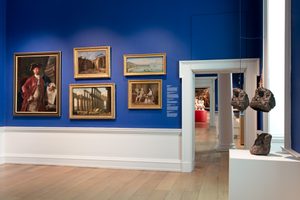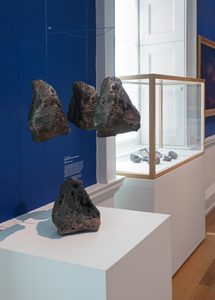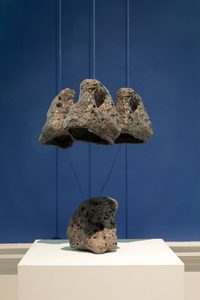
Naples collection
1600 – 1800
About the
Collection
Be transported to Naples where the scent of orange blossom drifts in the air and the spectacle of Vesuvius smoulders in the distance.
Our fantastic collection of 17th and 18th century Neapolitan paintings and objects are brought to life through interactive elements and contemporary art installations. Scent diffusers, music and a volcanic children’s play table recreate the smells, sounds, sights, tastes, and sensations of visiting this vibrant Italian city.
With thanks to International Flavors and Fragrances and the Wolfson Foundation.
We have one of the richest collections of Neapolitan art in the world outside Naples, representing a cross-section of works from the ‘Golden Age’ of Neapolitan art. By 1600 Naples was one of the largest cities in Europe, second only to Paris and with a population three times as large as Rome. It was a city of extremes, combining natural wonders and Catholic devotion with crime and poverty. These contrasts are suggested in the vivid religious, mythological and still life scenes of Luca Giordano (1634-1705), Francesco Solimena (1657-1747) and Giovan Battista Ruoppolo (1629-93). After 1700, the city became an established destination on the Grand Tour itinerary, with foreign visitors and artists alike drawn by the opportunity to witness a dramatic eruption from Mount Vesuvius.
Paintings by Gaspare Vanvitelli (1652/3-1736), Pietro Fabris (active 1754-1804) and Pierre-Jacques Volaire (1729-c.1792), and elaborate carved wooden and coral pieces capture the romantic appeal that Naples held for visitors. As well as examples of souvenirs made from the lava of Vesuvius and brought back to Britain in the eighteenth and nineteenth centuries.
New Commissions
Two commissions produced by living artists in response to works in the historic collection. Responding specifically on the theme of the senses the works were commissioned in partnership with disability arts platform Unlimited.
DYSPLA, a neuro-divergent led award-winning arts studio, created a work that speaks to Lorenzo Vaccaro’s marble busts of The Four Continents, through four new performative digital sculptures. Accessed via a QR code, these holographic sculptures invite you to engage with your own physicality through touch.
The senses of sight and sound are addressed in the second new artwork, which takes the form of three bronze bells and a piece of Vesuvius lava rock. The bells can be gently rung, and were created for Compton Verney by Aaron McPeake, an artist whose practice explores his own experience of sight loss later in life and the sound of church bells echoing across Naples.
Discover more
Download our gallery guide to find out more the Naples collection
and the artworks on display in our galleries
Pendant with the Immaculate Conception
Charles of Bourbon at the Battle of Gaeta
The Birth of the Virgin Mary
Venus with Iapis tending the Wounded Aeneas

Posillipo from the Riviera di Chiaia

The Grotto of Pozzuoli, with Virgil's Tomb

The Reception of Saint John of God into Heaven

The Holy Family with the Infant St John the Baptist

St Nicholas of Bari Received into Paradise

Still Life with Apples, Grapes and a Dragonfly

Venus with Iapyx Tending the Wounded Aeneas

Still Life with Fruit and Mushrooms

Still Life with Flowers in an Urn, Butterflies and a Snake

Priam, King of Troy, begging Achilles for the Body of Hector

Posillipo with the Palazzo Donn’Anna

Still Life with Figs, Cherries, Plums and Two Guinea Pigs

Still Life with Watermelons, Plums, Cherries, a Basket of Figs, Pears and a Monkey

The Bay of Naples seen from Posillipo

The Festival of the Madonna dell’Arco

Portrait of a Man Smoking a Pipe

Still Life with Melon, Peaches, Figs, Mulberries, Plums and Carnations
Trapani Mirror

Still Life with Apples, Cabbage, Parsnip and Lettuce

The Lanterna del Molo, Naples

Portrait of a Foreign Diplomat: Francesco Solimena

Sir William and the first Lady Hamilton in their villa in Naples

Peasants Merry-making on the Shore at Posillipo

Naples from the West, with Peasants Gaming

Pendant with the Immaculate Conception
































